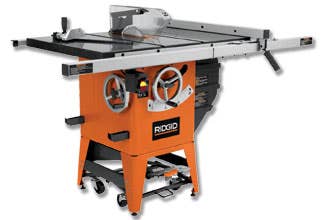High time for a hybrid saw
It’s not uncommon to have a small shop’s single table saw tied up when there’s a need for a series of cuts that only a table saw can do well….

It's not uncommon to have a small shop's single table saw tied up when there's a need for a series of cuts that only a table saw can do well. Is it time to panic or time to move another saw into position and start cutting?
{loadposition position10}
For most small shops, a second or third saw is not a large enough imperative to spring for another cabinet saw. Contractor's saws have been an option for many years, an option that is still available and quite low in cost. Job-site saws aren't much of an option for anything but job sites, or so it seems. Power is down. Noise is up. Dust collection isn't good. Dust collection is also not good - and not easily made good - with a contractor's saw.
Where did hybrids come from?
About a dozen years ago, DeWalt announced a hybrid saw - a cross between a contractor's saw and a cabinet saw. It debuted to fairly universal puzzlement as woodworkers tried to figure out just where it fit. In price, it usually falls between a similarly equipped cabinet saw and a contractor's saw. In power, most hybrids are mildly more powerful than most contractor's saws with 1-3/4 hp for the hybrid and 1-1/2 hp for the contractor's saw.
They are a step up from a contractor's saw, giving competition to the more costly ones. They're a step down from cabinet saws, saving money for the woodworker who doesn't need a saw to make hundreds of feet of rip cuts in maple, cherry or oak every week. The lack of a motor hanging off the back is appealing to many people, too.
Those baffled by the introduction didn't have too long to wait, though hybrid saw sales weren't explosive. They did take off enough for other makers to follow suit. Today, most table saw manufacturers also offer a hybrid version, sometimes two, and occasionally more than that.
Hybrid saws always have a longer cabinet than a contractor's saw, often fully enclosed down to the floor. Interiors are enclosed or baffled to allow good dust extraction, something that eludes almost all contractor's saws even today. Hybrids with full cabinets include Craftsman, Delta, Steel City and Woodtek. Those with 3/4 cabinets include DeWalt, Jet and Ridgid. Because all seem to emphasize good dust collection, the cabinet style is more of an appearance item than a real feature.
Fences used to be a major difference between cabinet saws and contractor's saws, though that has changed with a slightly lighter-duty version of the Biesemeyer T-square fence and a host of clones with and without upgrades. Usually, though, a contractor's saw needed a fence transplant to be really useful. Hybrids already come with excellent fence systems, mostly based on the Biesemeyer fence. I like the look of the new Craftsman T-square, though I haven't had a chance to really try it out. The HDPE surfaces remind me of the HTC table saw fence, one of the best made.
If you are interested in maintaining cabinet saw ease of adjustability, look for one of the hybrid saws that uses cabinet-mounted trunnions. As we all know, adjusting a contractor's saw ranges from a time-consuming task to a royal pain in the butt. Some of the hybrid saws offer the ease of adjustability of cabinet saws. Check at the time of purchase as to what is on a particular saw because it may vary from model to model within the same brand.
Saw weights
On the whole, hybrid saws are lighter than cabinet saws. They are usually heavier than contractor's saws, with most hybrids moving the needle to 275-325 lbs. or more. The DeWalt 746X comes in at a svelte 254 lbs., making it easy to walk around without wheels.
A note on the weight of the tops may be of interest: I weighed the extension wing from the Jet hybrid of cast iron. It was 40 lbs., give or take the vagaries of a home scale. The Ridgid weighed in at 54 lbs. Overall, that means the top and extensions probably weigh about 120 lbs. in cast iron, going to 215 lbs. or so in granite - a considerable difference.
Granite as a top
Granite makes some woodworkers nervous as a tool top because of its supposed fragility. In real life, granite is no more fragile than cast iron. Drop either one onto a concrete floor and major damage may result. Granite does chip a easier, but chips are simple to fill with epoxy, which is then sanded smooth.
We all know the major problem with cast iron: rust. If you live in a humid area, rust is a day-to-day nuisance, one that absorbs time in removal or prevention. Most woodworkers use a good paste wax for preventing rust but, even then, the top rusts when someone drips sweat or sets a Styrofoam coffee cup on it. Rust happens with ferrous metals that don't include nickel and the other ingredients of stainless steel.







